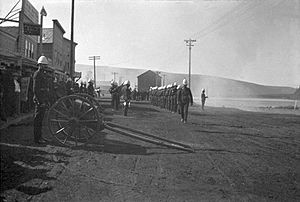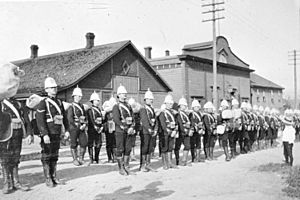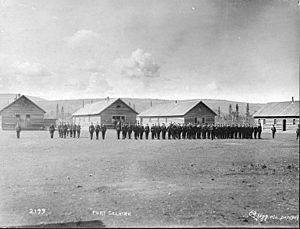Yukon Field Force facts for kids
Quick facts for kids Yukon Field Force |
|
|---|---|

The force on parade in Dawson City, 1900
|
|
| Active | 1898–1900 |
| Country | Canada |
| Branch | Permanent Force of the Canadian Militia |
| Role | Garrison |
| Size | 203 |
The Yukon Field Force was a special group of 203 Canadian soldiers. They served in the Yukon region from 1898 to 1900. This group was also called the Yukon Garrison.
They were sent because of the Klondike Gold Rush. Many people worried that the United States might try to take over the gold-rich area. The force left Ottawa, Canada, on May 6, 1898. They traveled by train and ship to Glenora in British Columbia.
From there, they had a very tough journey. They walked and used handmade boats for 890 kilometers (about 553 miles). Their goal was Fort Selkirk, where they set up their main base. A smaller group of 72 men went to Dawson City. This was a busy town where gold was found. Their job was to help the North-West Mounted Police. They even guarded the gold in local banks.
As fears of a takeover lessened, people wanted the soldiers to come home. The force was made half its size in July 1898. The remaining soldiers finally left the Yukon in June 1900.
Contents
Why the Force Was Needed

The Yukon Field Force was created after gold was found in northern Canada. This happened in the late 1800s. Before this, the Yukon had very few people. There were First Nations people and some European gold seekers.
Canada did not have a strong government presence there. The borders with Alaska were also not clear. The United States had bought Alaska from Russia in 1867. This caused arguments over the border.
There were almost no police in the Yukon. Canada's main army, the Permanent Active Militia, had only about 800 soldiers. The closest army base was in Winnipeg, Manitoba. That was about 3,800 kilometers (about 2,360 miles) away.
Gold discoveries grew, and by 1894, more people lived in the area. Leaders asked the government in Ottawa to help. They wanted to stop illegal alcohol sales. They also wanted to protect First Nations people. And they needed to collect taxes on goods.
A government surveyor named William Ogilvie warned Ottawa. He said Canada needed to act fast. Otherwise, the United States might take over the region. So, the North-West Mounted Police explored the area. They built a police station there in 1875.
In 1896, a huge amount of gold was found in the Klondike valley. This started a big gold rush. Miners from nearby areas rushed to the new town of Dawson. When news spread in 1897, about 100,000 more people came. They all hoped to find gold.
Only about 40,000 people actually reached the Klondike. Most of these new arrivals, about 60 to 80 percent, were from the United States. The mounted police sent more and more officers. They were worried the United States might try to claim the Klondike.
Getting Ready to Go
The idea to send soldiers to the Yukon came from Nathaniel Clarke Wallace. He suggested it in the Canadian Parliament in February 1898. The government then made a formal plan. It was approved on March 21.
Frederick Borden, the Minister of Militia and Defence, announced the plan in May. He said 200 soldiers would go to Fort Selkirk. This was the main town in the territory. The soldiers would help the mounted police. Sending soldiers was cheaper than sending more police officers. Soldiers were paid less.
Borden said the main job of the force was to protect Canada's land. They would also help keep law and order if needed.
The force had 203 members. This included 12 officers. There were 15 men from the Royal Canadian Dragoons. Forty-six men were from the Royal Canadian Artillery. And 130 men were from the Royal Regiment of Canadian Infantry.
Soldiers volunteered for this mission. They were told it would last at least two years. Many soldiers wanted to go. Some even extended their time in the army. The force was led by acting Lieutenant-Colonel Thomas Evans. He was a respected officer from Winnipeg. He had experience with cavalry, infantry, and artillery.
The soldiers had Lee–Enfield rifles. They also had two Maxim guns and two 7-pounder (3 kg) cannons. One cannon was brass, the other was steel. They brought sixty horses for transport.
Soldiers received special heavy black pea jackets and pants. They also got other warm clothes for winter. They had their regular uniforms too. They quickly bought 123,000 kg (about 271,000 pounds) of canned meat, biscuits, and flour.
Nine "artificers" went with the soldiers. These included boat builders and packers. Eleven government workers also joined. Four nurses from the Victorian Order of Nurses also traveled with them. They were going to work in the Yukon. The wife of a mounted police officer also joined to meet her husband. And Faith Fenton, a journalist, went to write about the journey for the Toronto Globe newspaper.
The Journey to the Yukon
By 1898, there were different ways to reach the Yukon. But most routes from eastern Canada went through parts of the United States. This worried Canadian leaders. They wanted to use "All-Canadian routes." These routes avoided entering the United States. It was important for the Yukon Field Force to use one of these. Also, a slower river route might take too long. The river could freeze early, trapping the soldiers.
The force left Ottawa by train on May 6. They were headed for Vancouver. In Vancouver, the force split into two groups. The soldiers and 80 metric tons (about 88 tons) of supplies went first. They traveled to Wrangell, then up the Stikine River. They used a ship called the Stikine Chief. Canada had rights to use this river without landing in the U.S. From there, they would travel overland and by river to Fort Selkirk.
The other 100 metric tons (about 110 tons) of supplies and the cannons went a different way. They were sent through St Michael in Alaska. From there, a steamer would take them to Dawson City.
The main force landed at Glenora on May 20. They then marched overland to Telegraph Creek. This was where the 250-kilometer (about 155-mile) Teslin Trail began. The force was divided into teams of 35 men for the march. An advance group of 50 men went ahead. Their job was to improve the trail. They also quickly used a steamer to reach Fort Selkirk. There, they would start rebuilding the fort.
The journey was very hard. The land was rough. Thomas Evans wrote about the heat, swamps, and mosquitoes. He said his men had only "hard biscuits, rancid strong bacon and black tea" to eat. They carried heavy backpacks. The local companies did not provide enough mules to carry their supplies.
When the force reached Teslin Lake, Evans left on a steamer. He took 80 men to join the team at Fort Selkirk. But the boat hit a rock when it came back for the rest of the men. So, the force crossed the lake using four scows and five smaller row boats. They had built these boats from local trees. They had planned to use them only for supplies.
The scows were 46 feet (about 14 meters) long. They could carry 15 metric tons (about 16.5 tons) of cargo and 30 men. They had sails and a stove for cooking. The force finally arrived at Fort Selkirk on September 11. They had traveled another 640 kilometers (about 398 miles) from Teslin Lake.
A small group of mounted police were already at Fort Selkirk. They watched the river traffic. The advance team of soldiers had worked with builders. They made good progress on the new fort buildings. The combined group finished the work. They built eleven log buildings around a central parade ground.
What They Did in the Yukon
The main base of the force stayed at Fort Selkirk. But in October and November 1898, 72 men went to Dawson City. They took one of the Maxim guns with them. They were there to help the mounted police.
The soldiers in Dawson protected the gold in the banks. They guarded prisoners. They also helped build local hospitals. And they fought fires. Dawson City was built of wood, so fires were a big danger. They also took part in some formal ceremonies.
The Fort Selkirk base was quite lonely. So, men were moved between the two places in winter. This helped reduce boredom. In the warmer months of 1899, the force did weekly military exercises. They also built a rifle range for shooting practice.
Going Home

By 1899, the risk of the United States taking over had passed. General Edward Hutton, the new head of the Canadian Militia, was not happy. He felt the Yukon Field Force was doing jobs that were not for soldiers. He thought having so many regular soldiers there stopped them from training the rest of the army.
So, half the force was sent home in July 1899. This time, they took a faster route. They went through White Pass and Skagway in United States territory. In October, the Boer War started in South Africa. Canada sent soldiers to help Britain.
Thomas Evans, the commander, left the Yukon in November to join the war effort. Major T. Hemming took over as the force's commander.
In May 1900, the force left Fort Selkirk. They focused only on Dawson. On June 25, the rest of the force was called back. They also returned via White Pass and Skagway. Their uniforms, rifles, and Maxim guns stayed behind. These were later used by a volunteer group called the Dawson Rifle Company. This group formed the next year. The cannons were given to the mounted police.
The mounted police stayed at Fort Selkirk. They used the force's old barracks until 1911.
Three buildings built by the force are still at Fort Selkirk today. These are the officers' residence and the old guard room. A local man moved them in the 1920s. They are now called "Coward Cabin" and "the Garage." The orderly room is still in its original spot.
The Yukon Field Force cemetery is nearby. Three soldiers and some local people are buried there. The force's two 7-pounder cannons are on display. You can see them at the Royal Canadian Mounted Police offices in Dawson City.
Four officers who served with the force became Major-Generals later. This happened during the First World War.




